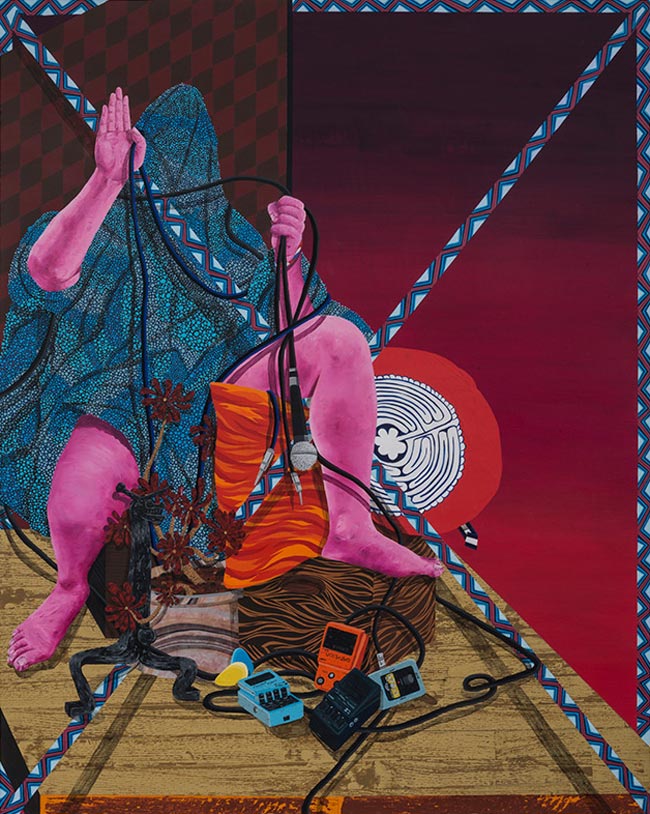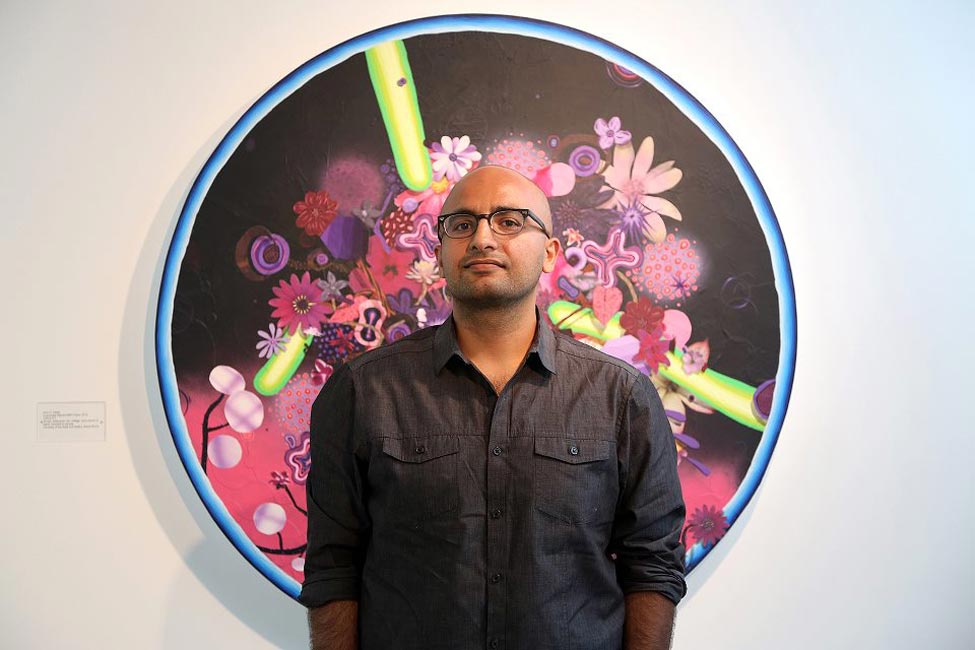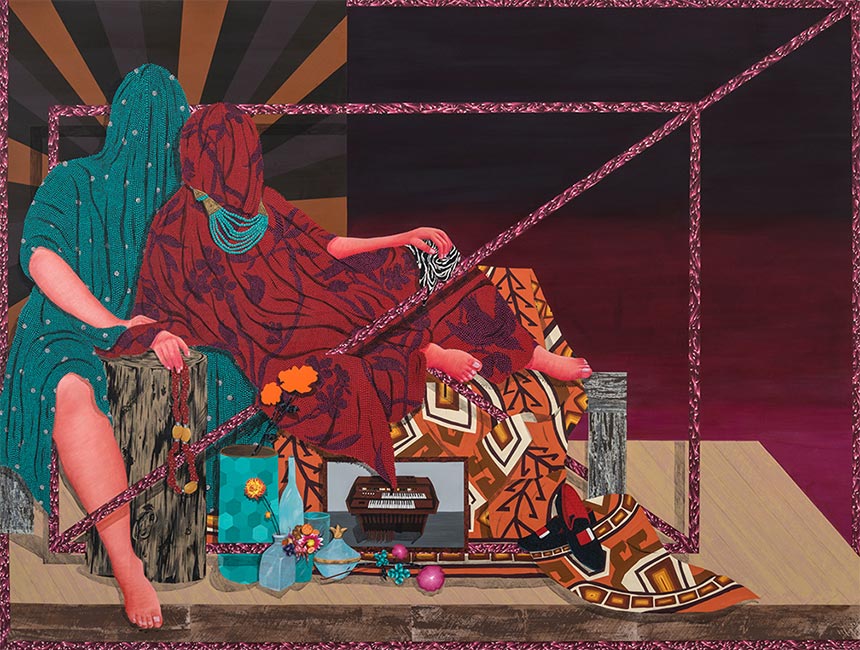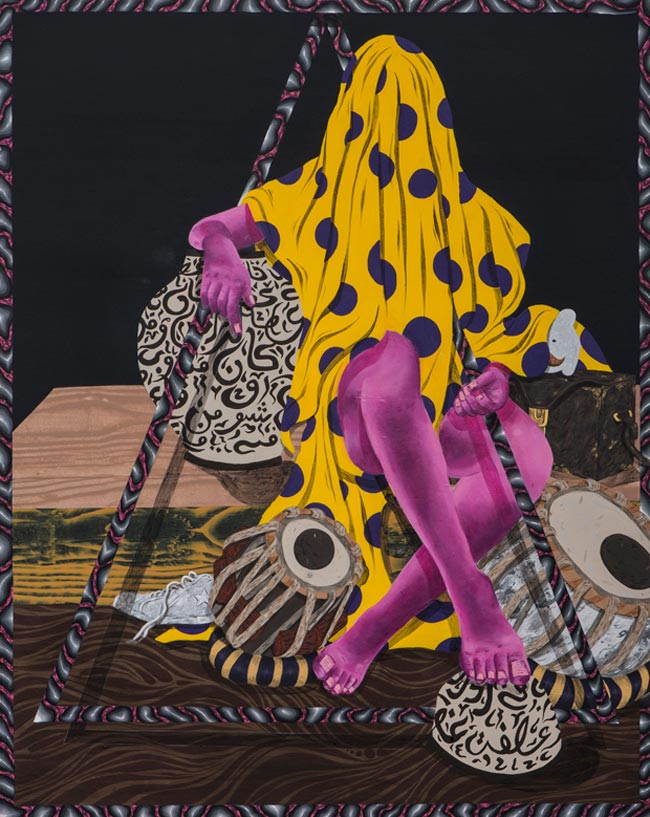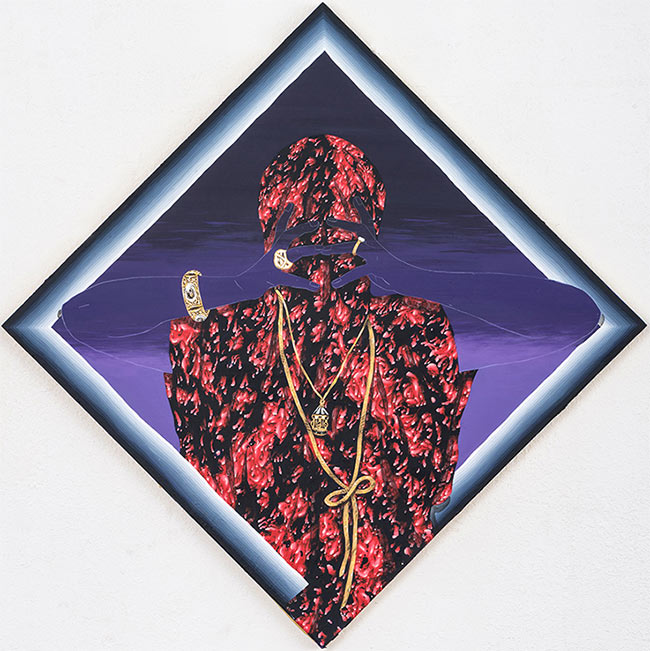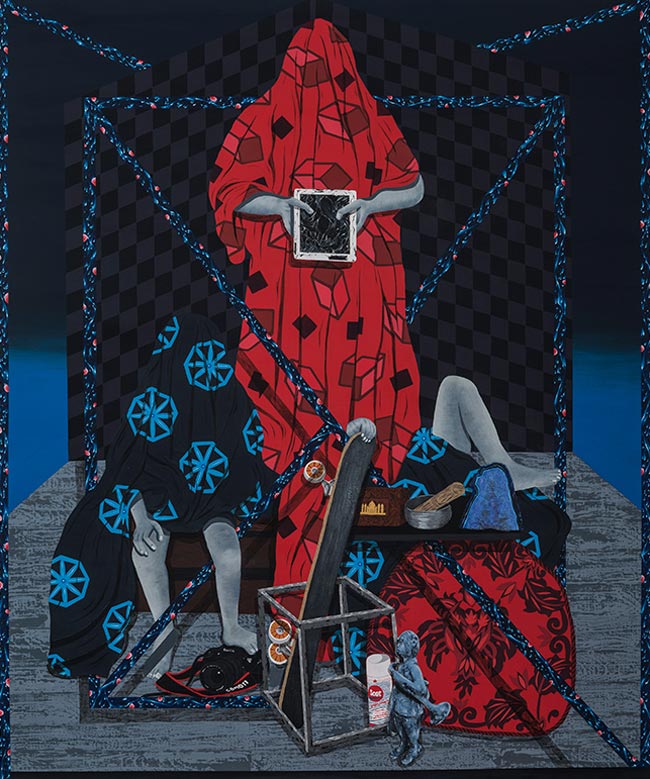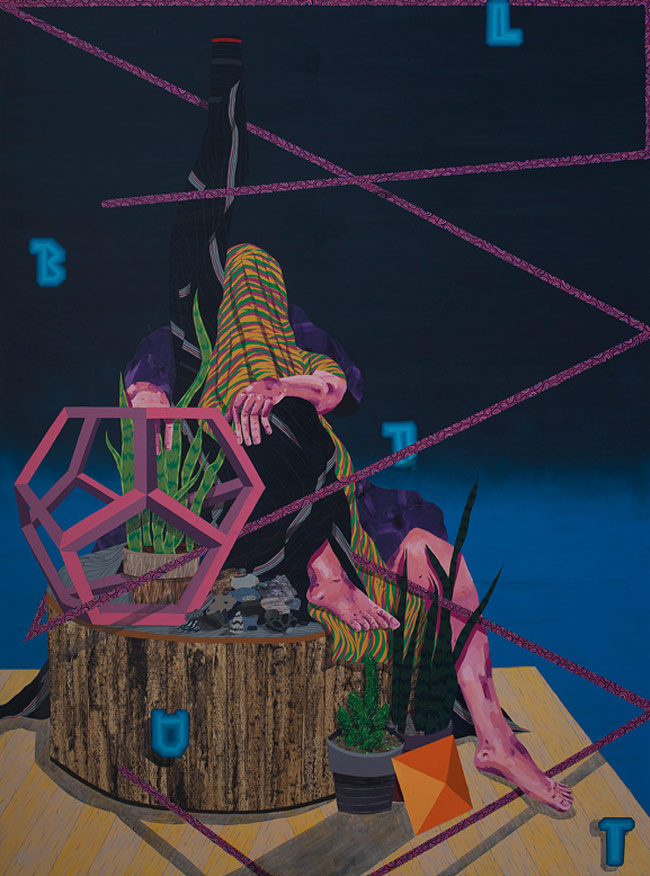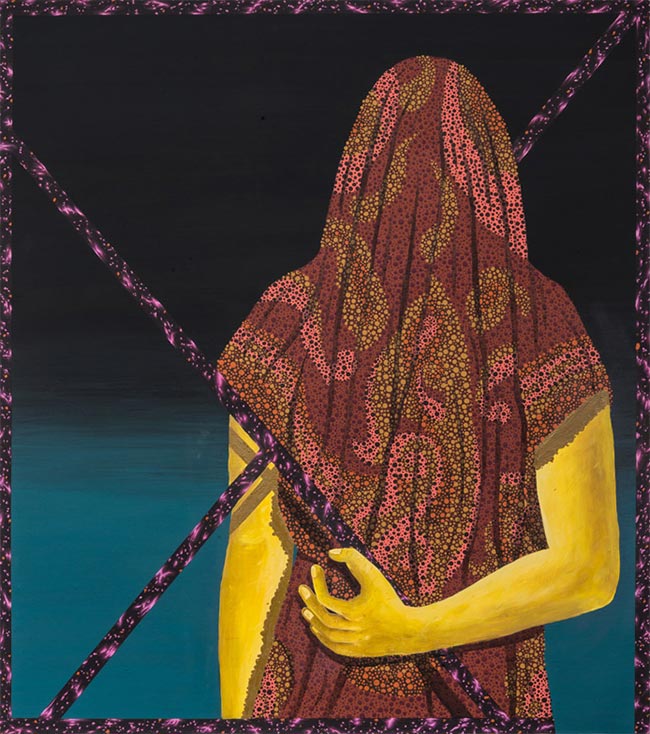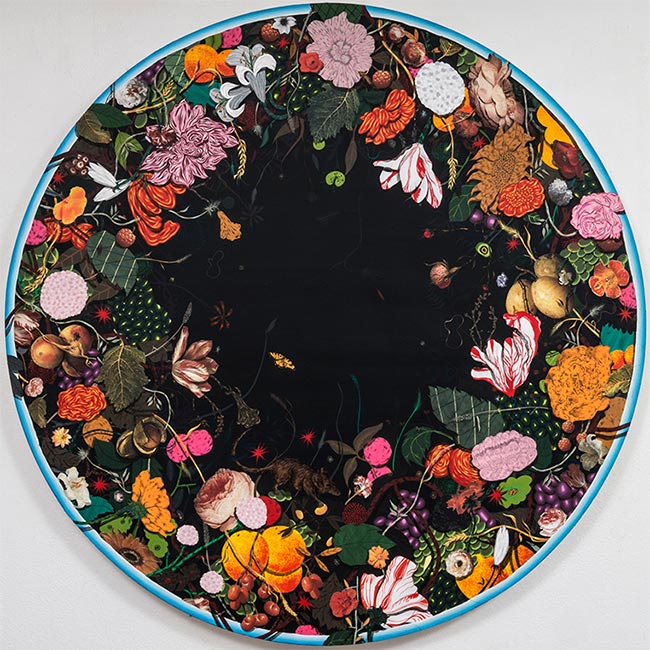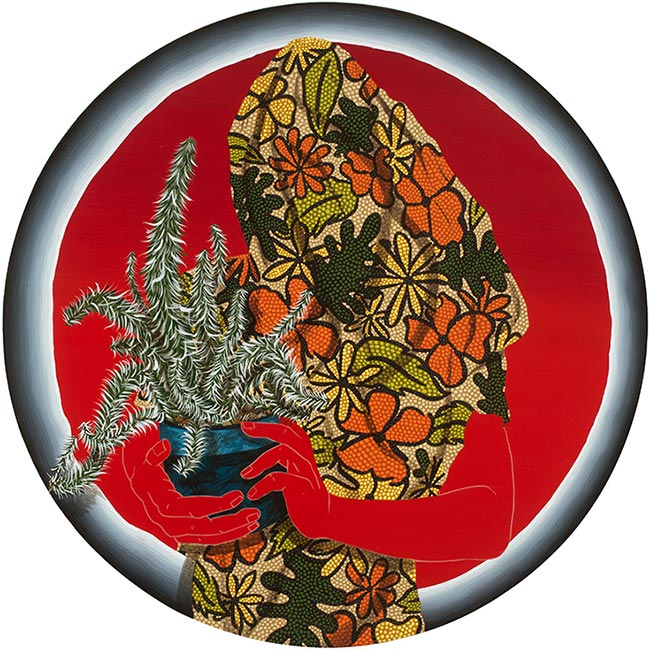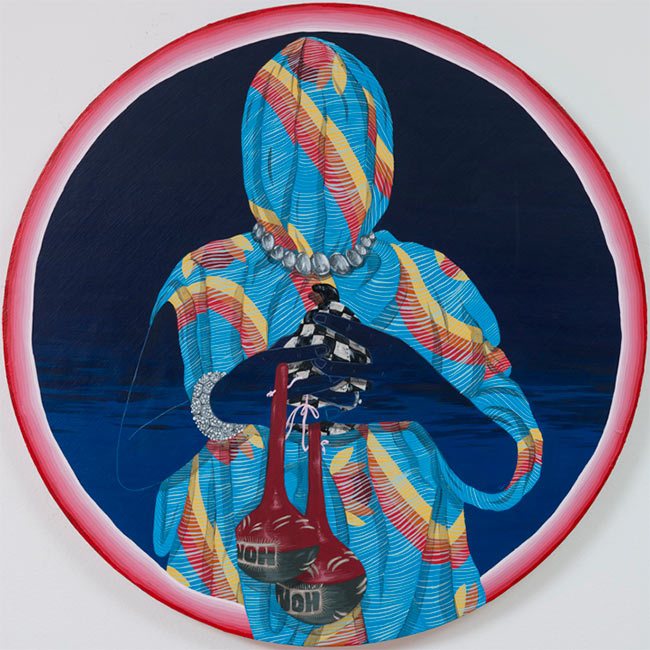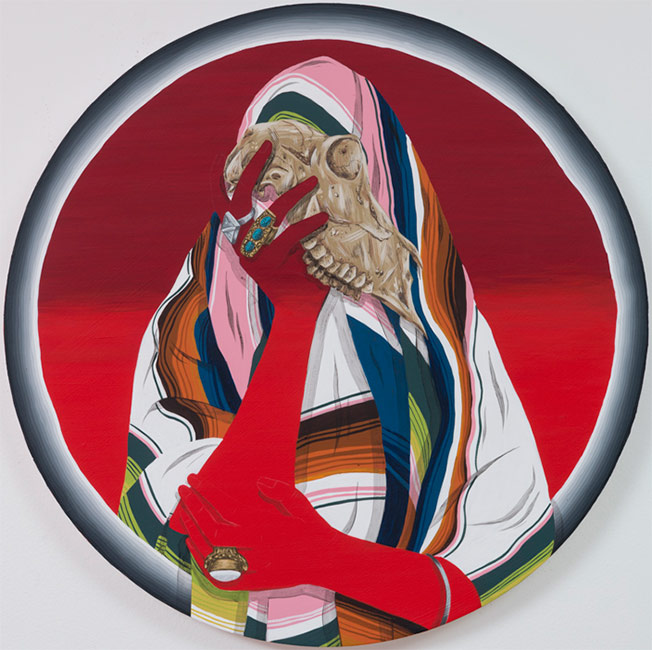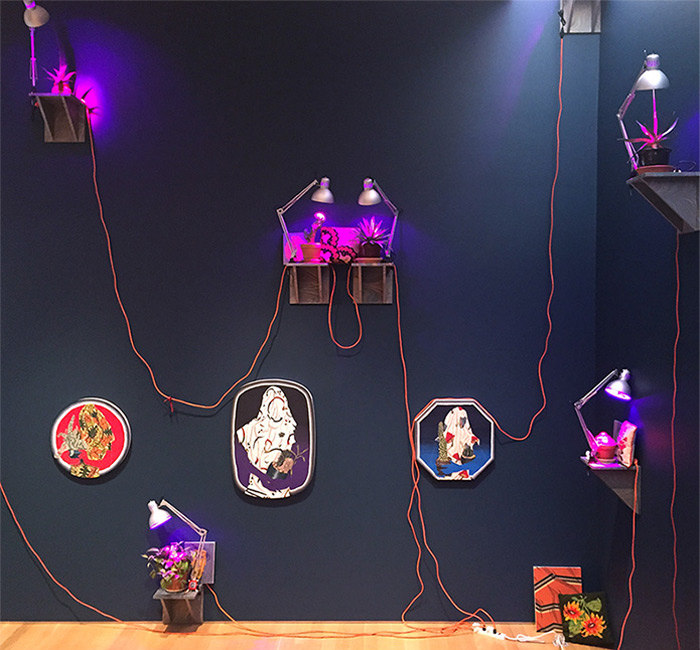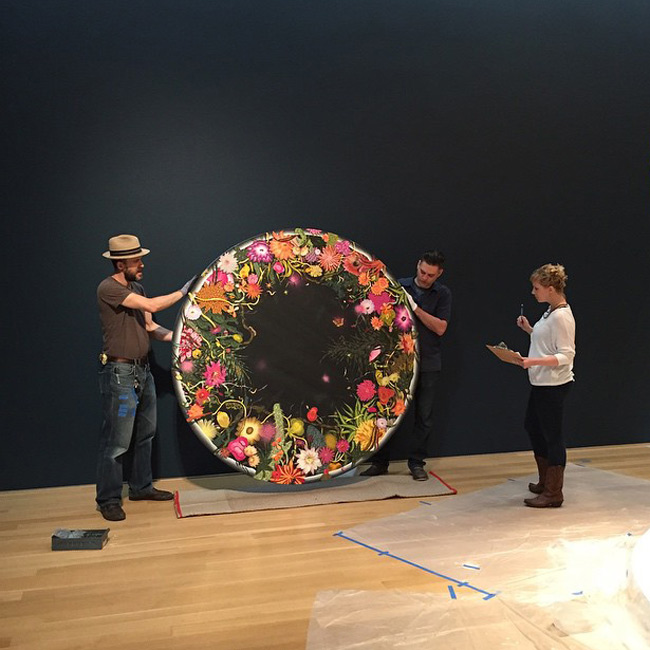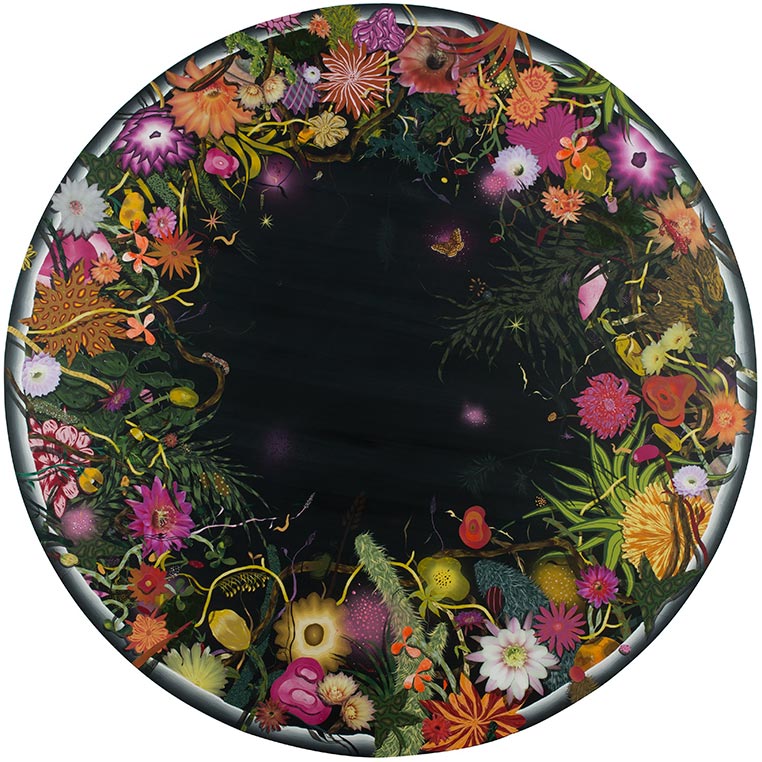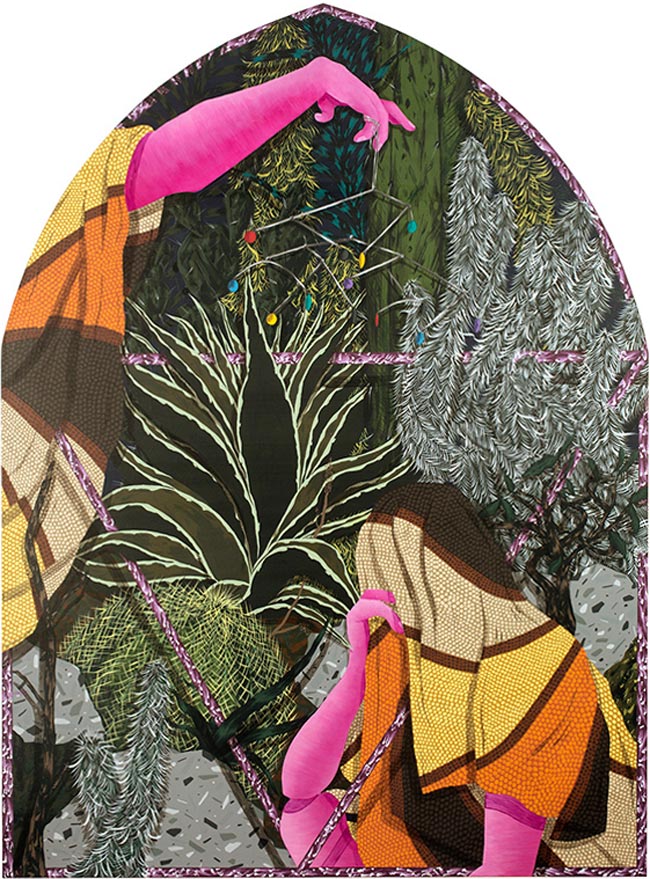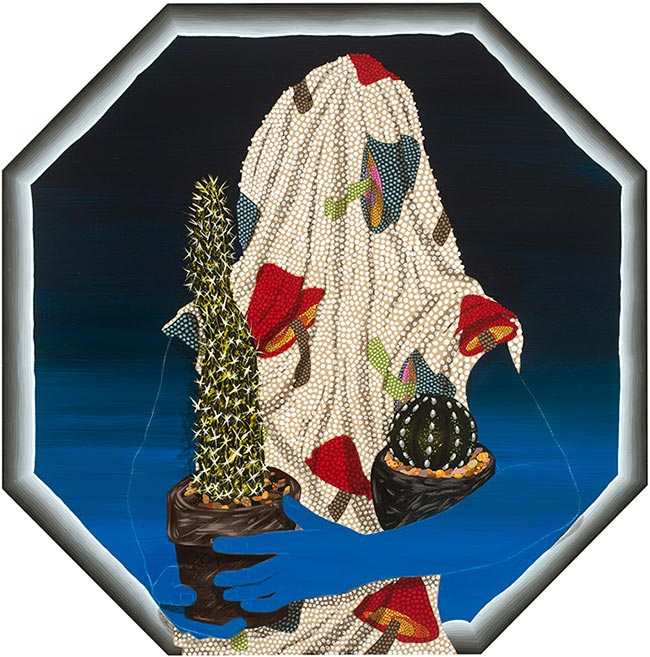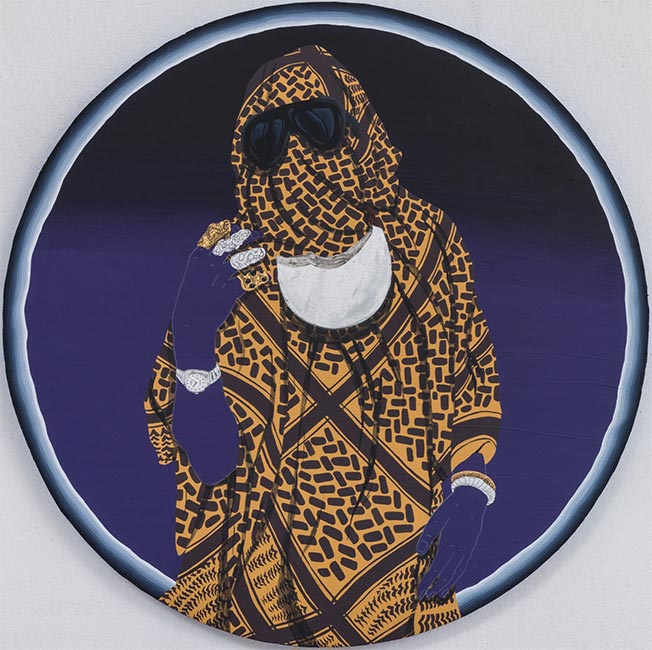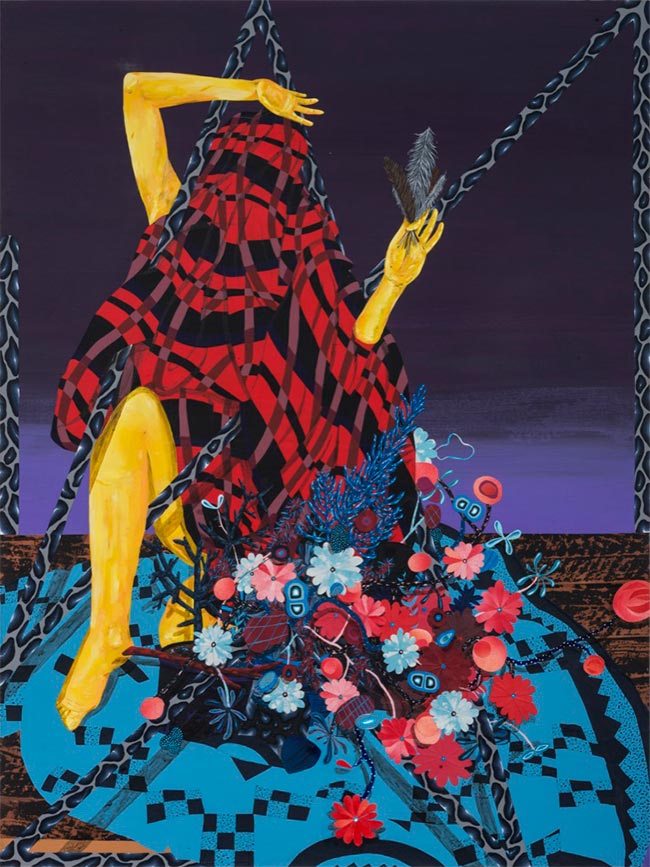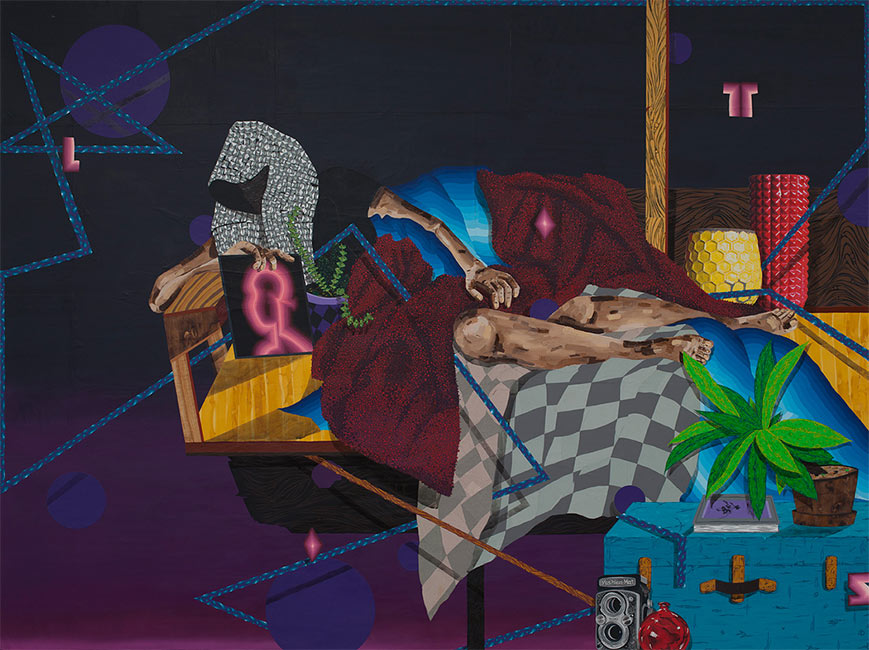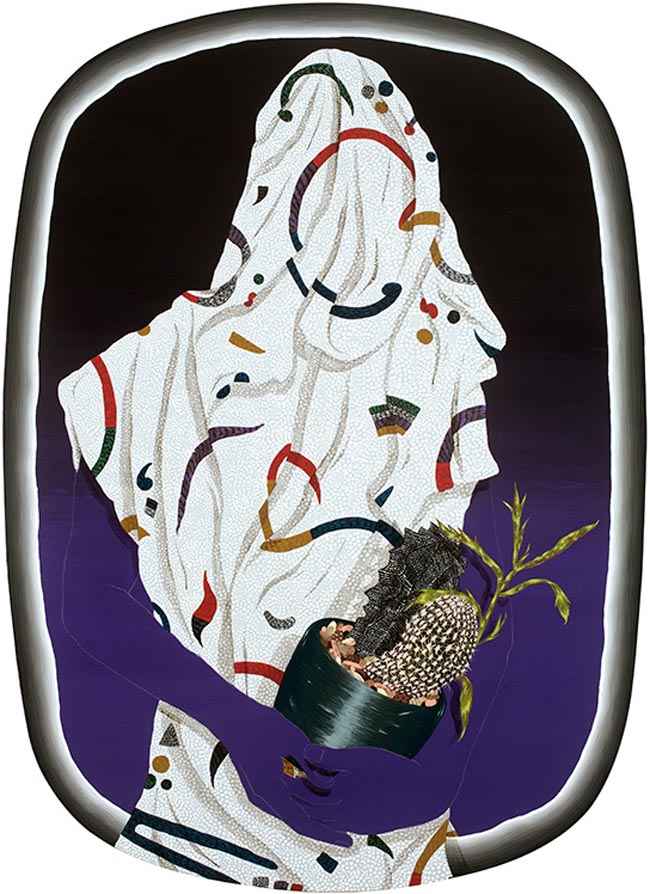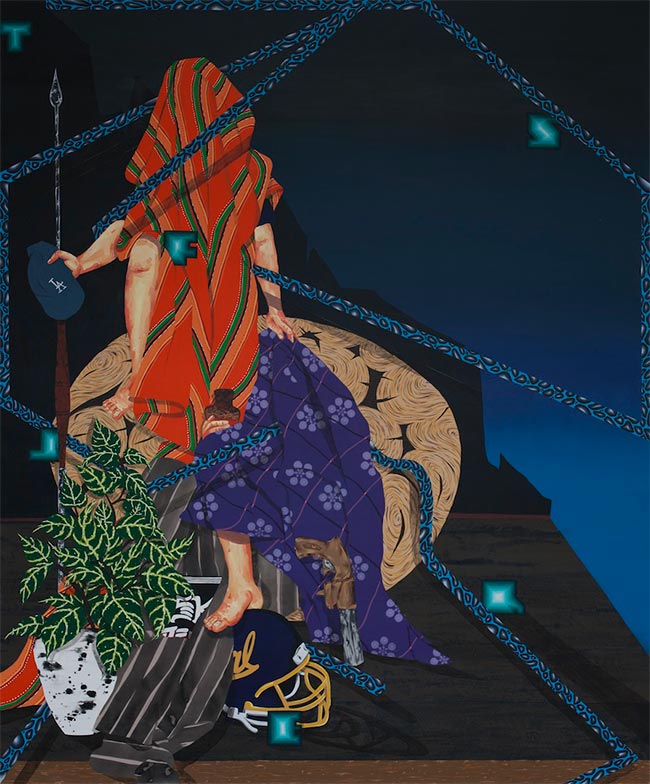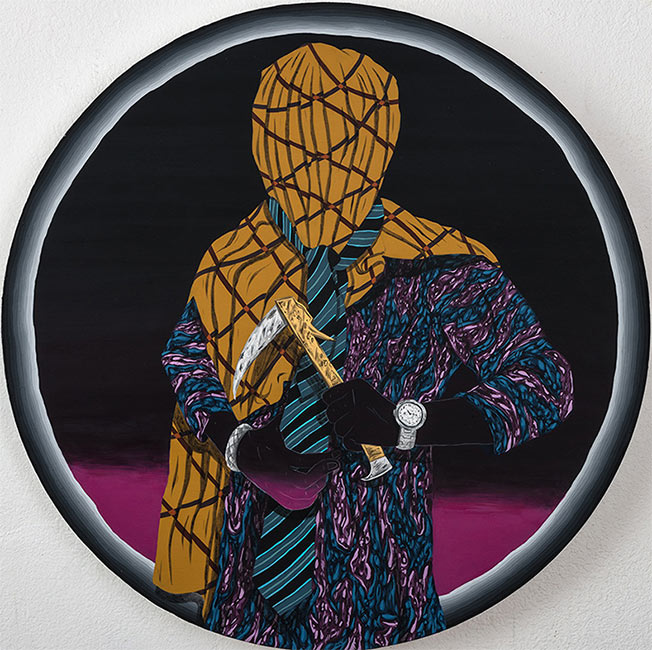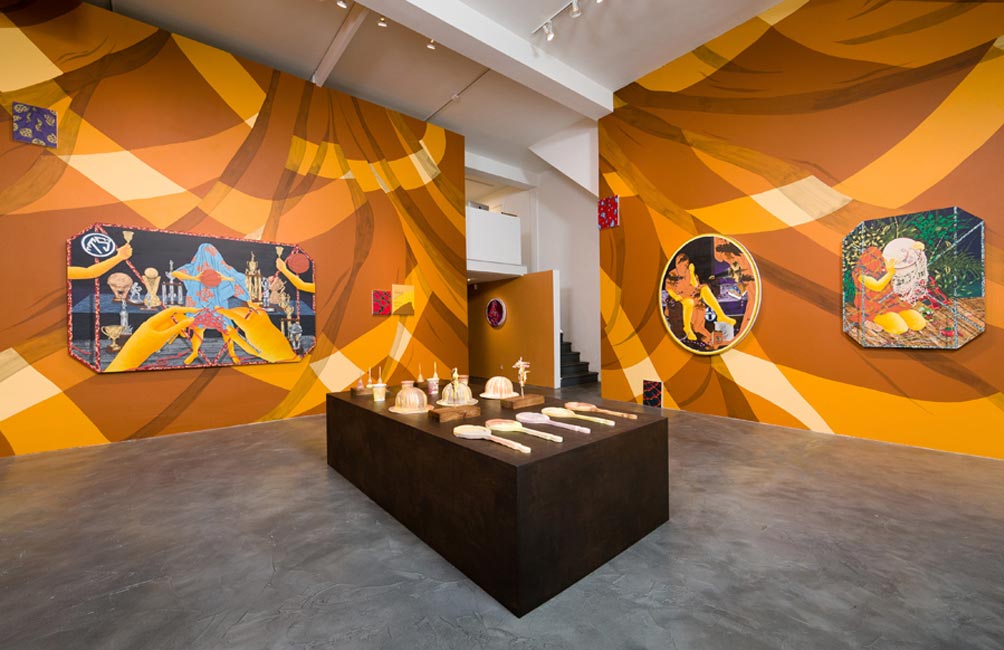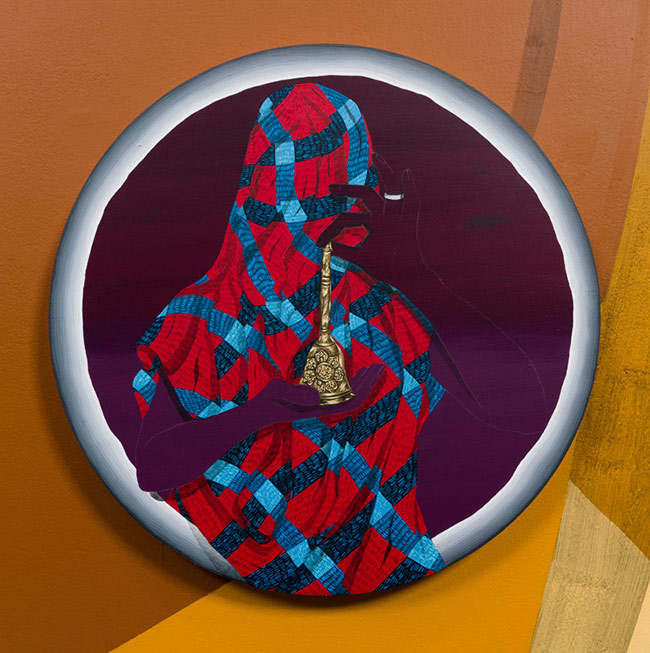Amir H. Fallah was born into an Iranian family and lived the first five years of his life in Iran, before moving to America. In his own words, the transitional adjustment which took place left him feeling something akin to a ‘cultural hybrid’. The biographical nature of Amir’s art and his fascination with the constructs of identity, are most likely linked to this aspect of his personal history. Through his work, Fallah asks us to question our preconceptions about the exterior façades of identity and the type of judgements we make based on these. By experimenting with, and essentially deconstructing the concept of art historical portraiture, Amir strips away our ability to judge a book by it’s cover, and instead encourages us to look beneath the surface and create our own individual and unbiased narratives.
Amir was born in Tehran, Iran in 1979 and he currently lives and works in California, USA. He received his BFA from Maryland Institute College of Art in 2001 and his MFA from the University of California Los Angeles in 2005. Amir has exhibited widely in solo shows across the United States and in the Middle East. His works are part of several private and public collections, including the Salsali Private Museum Collection.
WOW x WOW recently caught up with Amir as he was putting the finishing touches to ‘The Caretaker’, his site specific installation at the Nerman Museum in Kansas City. Read on to hear what he had to say.
Hi Amir, thanks for taking the time out to hook up with us for a chat, it’s most appreciated. To get the ball rolling if you could please introduce yourself, touching on anything you feel relevant to story of Amir H. Fallah the artist?
I grew up in Northern Virginia in the suburbs of DC. Bored to tears with the mundaneness of the burbs I moved an hour north to go to college in Baltimore, MD. After getting my undergrad degree I ended up in LA to go to grad school. I thought I was a die hard east coaster but after after spending a winter in the LA sunshine I decided to stay.
While I was in college I also started Beautiful/Decay magazine and ran it for several years. It initially started as a small art school project but quickly grew into a popular art/design magazine and blog. A couple years ago I decided to step away from the day to day operations of Beautiful/Decay to focus full time in the studio.
The identities of your paintings subjects are encrypted in various ways, but you give us clues to aid us in solving the puzzle of whose psyche is being depicted in each piece. What thoughts and insight about the subject of the portrait do you wish for the viewer to take away with them?
When I first started on the series of portraits, I was interested in figuring out a way to create a deconstructed portrait. How do you depict someone without showing the usual signifiers that we associate with a portrait like the face, skin color, race, age..etc.? How do you describe someone if you can’t see what they look like? As the series evolved I began to collaborate with my subjects. I would visit their home and get to know them. We would walk through their home and talk about the various things that they live with. An old quilt on the bed may look banal at first glance but it could also be a family heirloom that was passed down from generation to generation and charged with stories and memories. I look for these types of objects. The everyday materials that we all live with that tell the story of who we are. I take a grouping of these objects and create a still life of sorts with my subject at the center. Rather than depict their likeness, I create a portrait of them via the objects they surround themselves with. I photograph them and later in the studio I edit and manipulate the photos. It’s important to mention that the portraits are not a one to one translation of the photos. Once I have my source images I change the image greatly. The final piece is a symbolic collage of conceptual and formal elements that describe the person based on the discussions we have as well as the objects that they live with. At times it’s immediately clear who the person is and at other times the painting takes on a life of it’s own and is harder to decode.
Having been born in Iran and then moving to America when you were five, you have referred to yourself as a ‘cultural hybrid’. In what ways do you feel that your own story has shaped the subject matter you explore, and in particular those themes surrounding identity?
I can’t help but think that my layered and at times confusing cultural upbringing informs the work on some level. Growing up, my life was full of contradictions. It can be challenging to ‘find yourself’ when you’re expected to live up to two disparate identities simultaneously. Because of this, my work has always had a biographical component to it. I’m interested in real people and their stories; what happens when you take away the exterior and get to know who someone really is. People’s lives are more fascinating than any fiction I’ve ever read or seen. Perhaps that’s why I can’t stand super hero movies and watch dozens of documentaries every week.
The art of the Persian miniature has been influential to your painting.Tell us a little about how your relationship with these works of art began and their particular relevance to your own work?
Growing up in an Iranian home, the first artworks I saw were reproductions of Persian miniatures. I’d always loved the flat graphic nature of these works. I was also fascinated with their lack of perspective and depth. Because of this, the compositions in most Persian miniatures are stacked, rather than receding into space. It could be seen as a mistake, but to me that’s what makes them wonderful. I employ this same use of perspective in some parts of my work. I want my paintings to simultaneously read as having depth, as well as look flat depending on where you look at the painting.
Another big influence has been my appropriation of the decorative borders on Persian miniatures. Traditionally these borders were meant to read as literal windows into the story or tale that the miniature was depicting. In contemporary painting you hear a lot about how the canvas is an illusionistic field for the artist to create on. The painting is meant to continue off of the canvas and the viewer is supposed to complete the image in their mind. By adding the lines that act as borders in my work I’m reinforcing the edges of the paintings signaling to the viewer that the image ends here. Everything that they need to think about is happening on the surface right in front of them.
Sticking with the topic of art history, you have previously stated that you make art historical references in your work. What is your general relationship with art history and how important do you feel it is for you as an artist, to have a knowledge of what has gone before you?
Art history is a must for any artist. You can’t make work that is contemporary if you have no knowledge of what has happened in the past. My work is full of references to art history as well as other things that I’m interested in. You’ll find references to Dutch and Flemish Golden Age, still life painting sitting next to references to Francis Bacon.
A diverse combination of mark making is evident in your work. How important is it to you that your artist’s hand is obvious to the viewer?
My paintings always read very flat and graphic in reproductions but in person they have more of my hand present. It’s important to me that my work feels handmade. I want all the mistakes of my hand to be present. All the fumbling, happy accidents, and intuitive decisions are recorded on the surface for the viewers to explore. I’m also a maximalist when it comes to painting. I use a wide array of mark making within one painting. You might see a glazed hand that took 3 weeks to paint sitting next to piece of fabric that is made out of thousands of dots. Some would say I have art supply A.D.D. It’s hard to tell but I use quite a bit of collage in my work as well. All the various painting techniques and collage add a certain degree of tension to the works that keeps them from looking too stiff and tight.
Your paintings explore a multitude of fascinating concepts. It is also apparent that it’s your intention for them to be aesthetically beautiful objects. What are your thoughts on aesthetic beauty and its importance within the world of art?
To some, beauty is a dirty word, but for me it’s a way to draw the viewer in. I want to seduce the viewer into staying with my work for as long as possible. I think of the paintings as having many layers. The more you dig in the more you get out of them. For instance, one thing I love is that I can have a discussion about my work with someone with no background in art as well as an art historian. I’d like to think that there’s a little bit of something for everyone. With that said, I’m always suspicious of work that is too pretty. I’d hate to make work that was beautiful but that didn’t have a conceptual bend to it. I’d like to think that you come for the beauty but you stay for the content.
Do the interpretations viewers offer about your work ever end up influencing what you produce? What are your thoughts about the dialogue and conversation cycle which is created between the artist and viewer?
They can at times but the older I’ve gotten the more I’ve realized that I have to follow my own path regardless of what others want. Viewers can bring their own wants and needs to the work. I’ve found that the more I look within, the better the work gets. I do however have a small group of fellow artists that I regularly do studio visits with. They know my work well and can give feedback that can be immensely helpful.
High and low cultures are fused in your interests and inspirations. With a background in skateboarding and graffiti sitting next to formal art training and now a career as a fine artist, what distinctions and similarities between high and low culture do you like contemplate and make reference to in your work?
I’m a visual content junkie. I don’t make distinctions between high and low within my work. I will borrow an element from an album cover as well as a composition from a painting from the Renaissance. I compare it to how a DJ might sample various forms of music to make something new. The more complex and layered the references, the better in my opinion.
In order to get a better understanding of the personality of an artist, it can help to get a peek behind the curtain. Would you be willing to share a story from your own life, one which you feel has contributed to shaping the person and therefore the artist you are today?
I went to grad school when I was only 22 years old and had an allstar team of artists as professors, who would go in and out of my studio giving me their two cents. Being young, I didn’t realize that I didn’t have to take every piece of advice that was sent my way. This resulted in a lot of confusion in the work. For three years I was pulling things out and adding things to everything I made. By the end of it I felt completely confused about what my work was about and what I wanted to say. I spent about four years getting all those voices out of my head. I probably would have benefited from going to grad school when I was a bit older and wiser. I think it’s very important for artists to be open to critique and suggestions, but to also follow their own voice. It can be complicated and confusing to have many voices telling you to do this or that. Going through all that certainly informed who I am today. Perhaps all that confusion was necessary to get me to where I am today.
What’s next for Amir H. Fallah?
My next project is a large site specific installation at the Nerman Museum in Kansas City called The Caretaker. This will be my first major museum show and will also be my most complicated install to date. The show features a new series of paintings, sculpture, and tapestry all revolving around one individual who lives in KC. It’s the first time I’ve created an entire body of work about one person so it should be interesting.

